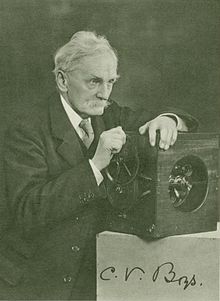C. V. Boys
| Sir Charles Vernon Boys | |
|---|---|

Sir Charles Vernon Boys, FRS
|
|
| Born | 15 March 1855 Wing, Rutland |
| Died |
30 March 1944 (aged 89) St Mary Bourne, Andover, Hampshire |
| Citizenship | British |
| Fields | physicist |
| Notable awards | Royal Medal (1896) Duddell Medal and Prize (1924) Rumford Medal (1924) Elliott Cresson Medal (1939) |
Sir Charles Vernon Boys, FRS (15 March 1855 – 30 March 1944) was a British physicist, known for his careful and innovative experimental work.
Boys was the eighth child of the Reverend Charles Boys, the Anglican vicar of Wing, Rutland. He was educated at Marlborough College and the Royal School of Mines, where he learned physics from Frederick Guthrie and taught himself higher mathematics while completing a degree in mining and metallurgy. As a student at the School of Mines he invented a mechanical device (which he called the "integraph") for plotting the integral of a function. He worked briefly in the coal industry before accepting Guthrie's offer of a position as "demonstrator."
Boys achieved recognition as a scientist for his invention of the fused quartz fibre torsion balance, which allowed him to measure extremely small forces. He made the fused quartz fibres for his instrument by attaching a quartz rod to a crossbow quarrel, heating the rod to the point of melting, and firing the crossbow. By this means he produced fibre so thin that it could not be resolved with an optical microscope. He used this invention to build a radiomicrometer capable of responding to the light of a single candle more than one mile away, and used that device for astronomical observations. In 1895 he published a measurement of the gravitational constant G that improved upon the accuracy achieved by Cavendish. Boys' method relied on the same theory as Cavendish's, but used two masses suspended at one height and two nearby masses suspended at a different height, to minimize the unwanted interaction between opposite masses.
...
Wikipedia
